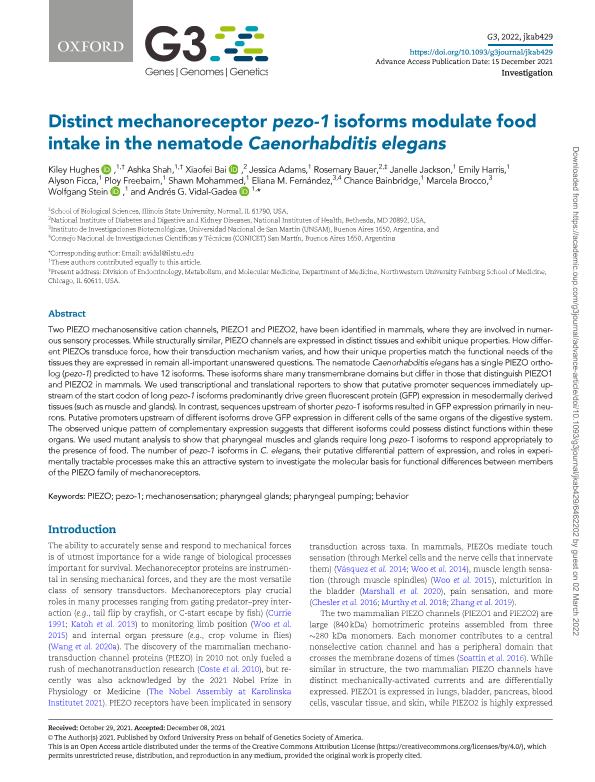Mostrar el registro sencillo del ítem
dc.contributor.author
Hughes, Kiley
dc.contributor.author
Shah, Ashka
dc.contributor.author
Bai, Xiaofei
dc.contributor.author
Adams, Jessica
dc.contributor.author
Bauer, Rosemary
dc.contributor.author
Jackson, Janelle
dc.contributor.author
Harris, Emily
dc.contributor.author
Ficca, Alyson
dc.contributor.author
Freebairn, Ploy
dc.contributor.author
Mohammed, Shawn
dc.contributor.author
Fernandez, Eliana Mailen

dc.contributor.author
Bainbridge, Chance
dc.contributor.author
Brocco, Marcela Adriana

dc.contributor.author
Stein, Wolfgang
dc.contributor.author
Vidal Gadea, Andrés G.
dc.date.available
2022-12-27T12:42:57Z
dc.date.issued
2021-12
dc.identifier.citation
Hughes, Kiley; Shah, Ashka; Bai, Xiaofei; Adams, Jessica; Bauer, Rosemary; et al.; Distinct mechanoreceptor pezo-1 isoforms modulate food intake in the nematode Caenorhabditis elegans; Genetics Society of America; G3: Genes, Genomes, Genetics; 12; 3; 12-2021; 1-13
dc.identifier.uri
http://hdl.handle.net/11336/182475
dc.description.abstract
Two PIEZO mechanosensitive cation channels, PIEZO1 and PIEZO2, have been identified in mammals, where they are involved in numerous sensory processes. While structurally similar, PIEZO channels are expressed in distinct tissues and exhibit unique properties. How different PIEZOs transduce force, how their transduction mechanism varies, and how their unique properties match the functional needs of the tissues they are expressed in remain all-important unanswered questions. The nematode Caenorhabditis elegans has a single PIEZO ortholog (pezo-1) predicted to have 12 isoforms. These isoforms share many transmembrane domains but differ in those that distinguish PIEZO1 and PIEZO2 in mammals. We used transcriptional and translational reporters to show that putative promoter sequences immediately upstream of the start codon of long pezo-1 isoforms predominantly drive green fluorescent protein (GFP) expression in mesodermally derived tissues (such as muscle and glands). In contrast, sequences upstream of shorter pezo-1 isoforms resulted in GFP expression primarily in neurons. Putative promoters upstream of different isoforms drove GFP expression in different cells of the same organs of the digestive system. The observed unique pattern of complementary expression suggests that different isoforms could possess distinct functions within these organs. We used mutant analysis to show that pharyngeal muscles and glands require long pezo-1 isoforms to respond appropriately to the presence of food. The number of pezo-1 isoforms in C. elegans, their putative differential pattern of expression, and roles in experimentally tractable processes make this an attractive system to investigate the molecular basis for functional differences between members of the PIEZO family of mechanoreceptors.
dc.format
application/pdf
dc.language.iso
eng
dc.publisher
Genetics Society of America
dc.rights
info:eu-repo/semantics/openAccess
dc.rights.uri
https://creativecommons.org/licenses/by-nc-sa/2.5/ar/
dc.subject
BEHAVIOR
dc.subject
MECHANOSENSATION
dc.subject
PEZO-1
dc.subject
PHARYNGEAL GLANDS
dc.subject
PHARYNGEAL PUMPING
dc.subject
PIEZO
dc.subject.classification
Bioquímica y Biología Molecular

dc.subject.classification
Ciencias Biológicas

dc.subject.classification
CIENCIAS NATURALES Y EXACTAS

dc.title
Distinct mechanoreceptor pezo-1 isoforms modulate food intake in the nematode Caenorhabditis elegans
dc.type
info:eu-repo/semantics/article
dc.type
info:ar-repo/semantics/artículo
dc.type
info:eu-repo/semantics/publishedVersion
dc.date.updated
2022-09-20T11:05:09Z
dc.identifier.eissn
2160-1836
dc.journal.volume
12
dc.journal.number
3
dc.journal.pagination
1-13
dc.journal.pais
Estados Unidos

dc.description.fil
Fil: Hughes, Kiley. University Of Illinois. Deparment Of Biological Science; Estados Unidos
dc.description.fil
Fil: Shah, Ashka. University Of Illinois. Deparment Of Biological Science; Estados Unidos
dc.description.fil
Fil: Bai, Xiaofei. National Institutes of Health; Estados Unidos
dc.description.fil
Fil: Adams, Jessica. University Of Illinois. Deparment Of Biological Science; Estados Unidos
dc.description.fil
Fil: Bauer, Rosemary. University of Chicago; Estados Unidos
dc.description.fil
Fil: Jackson, Janelle. University Of Illinois. Deparment Of Biological Science; Estados Unidos
dc.description.fil
Fil: Harris, Emily. University Of Illinois. Deparment Of Biological Science; Estados Unidos
dc.description.fil
Fil: Ficca, Alyson. University Of Illinois. Deparment Of Biological Science; Estados Unidos
dc.description.fil
Fil: Freebairn, Ploy. University Of Illinois. Deparment Of Biological Science; Estados Unidos
dc.description.fil
Fil: Mohammed, Shawn. University Of Illinois. Deparment Of Biological Science; Estados Unidos
dc.description.fil
Fil: Fernandez, Eliana Mailen. Universidad Nacional de San Martín. Instituto de Investigaciones Biotecnológicas. - Consejo Nacional de Investigaciones Científicas y Técnicas. Oficina de Coordinación Administrativa Parque Centenario. Instituto de Investigaciones Biotecnológicas; Argentina
dc.description.fil
Fil: Bainbridge, Chance. University Of Illinois. Deparment Of Biological Science; Estados Unidos
dc.description.fil
Fil: Brocco, Marcela Adriana. Universidad Nacional de San Martín. Instituto de Investigaciones Biotecnológicas. - Consejo Nacional de Investigaciones Científicas y Técnicas. Oficina de Coordinación Administrativa Parque Centenario. Instituto de Investigaciones Biotecnológicas; Argentina
dc.description.fil
Fil: Stein, Wolfgang. University Of Illinois. Deparment Of Biological Science; Estados Unidos
dc.description.fil
Fil: Vidal Gadea, Andrés G.. University Of Illinois. Deparment Of Biological Science; Estados Unidos
dc.journal.title
G3: Genes, Genomes, Genetics
dc.relation.alternativeid
info:eu-repo/semantics/altIdentifier/url/https://academic.oup.com/g3journal/advance-article/doi/10.1093/g3journal/jkab429/6462202
dc.relation.alternativeid
info:eu-repo/semantics/altIdentifier/doi/http://dx.doi.org/10.1093/g3journal/jkab429
Archivos asociados
